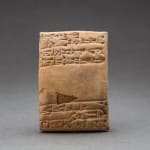Sumerian Cuneiform Tablet, 2026 BCE
Clay
2 x 2.95
CT.024
Sumerian cuneiform is one of the earliest known forms of written expression. First appearing in the 4th millennium BC in what is now Iraq, it was dubbed cuneiform (‘wedge-shaped’) because...
Sumerian cuneiform is one of the earliest known forms of written expression. First appearing in the 4th millennium BC in what is now Iraq, it was dubbed cuneiform (‘wedge-shaped’) because of the distinctive wedge form of the letters, created by pressing a reed stylus into wet clay. Early Sumerian writings were essentially pictograms, which became simplified in the early and mid 3rd millennium BC to a series of strokes, along with a commensurate reduction in the number of discrete used (from c.1500 to 600). The script system had a very long life and was used by the Sumerians as well as numerous later groups – notably the Assyrians, Elamites, Akkadians and Hittites – for around three thousand years. Certain signs and phonetic standards live on in modern languages of Middle and Far East, but the writing system is essentially extinct. It was therefore cause for great excitement when the ‘code’ of ancient cuneiform was cracked by a group of English, French and German Assyriologists and philologists in the mid 19th century AD. This opened up a vital source of information about these ancient groups that could not have been obtained in any other way.
Cuneiform was used on monuments dedicated to heroic – and usually royal – individuals, but perhaps its most important function was that of record keeping. The palace-based society at Ur and other large urban centres was accompanied by a remarkably complex and multifaceted bureaucracy, which was run by professional administrators and a priestly class, all of whom were answerable to central control. Most of what we know about the way the culture was run and administered comes from the cuneiform tablets, which record the everyday running of the temple and palaces complexes in minute detail, as in the present case. The Barakat Gallery has secured the services of Professor Lambert (University of Birmingham), a renowned expert in the decipherment and translation of cuneiform, to examine and process the information on these tablets. The following is a transcription of his analysis of this tablet:
This tablet consists of 14 lines of Sumerian cuneiform on obverse and reverse. Written is a very large and clear hand, a little damage, but everything can be read and the greater part is excellently preserved. An administrative document from the period of the Third Dynasty of Ur, dated to the third year of Ibbi-Sin, last king of the dynasty, c. 2026 BC. It is an account for wool:
Translation:
289 talents, 23 minas of ….. wool.
Loin cloths at 2 minas each: 9 talents 38 2/3 minas, 6 shekels, 299 talents, 1 2/3 minas, 6 shekels of wool.
Total involved: from it: 266 talents 28 minas of wool: wool rations for serfs, 28 talents of wool, document of Dayyan-ili.
Year: Ibbi-Sin, king of Ur, destroyed Simurrun.
The measures used are the talent of 60 minas, and the mina of 60 shekels. The mina was equal to about 500 grams. Thus it is clear that the third entry (299 talents, etc.) is the sum of the two previous entries. But if one substracts the 226.28 from 299.1.46 this does not leave 28 talents. There is no reason to suspect error: the scribe has simply not given in full all the relevant matters. This is a less common type of Ur III document and reflects the fact that sheep and goats were the common domestic animals, so Sumer became a centre for production of wool and woollen cloth.
Cuneiform was used on monuments dedicated to heroic – and usually royal – individuals, but perhaps its most important function was that of record keeping. The palace-based society at Ur and other large urban centres was accompanied by a remarkably complex and multifaceted bureaucracy, which was run by professional administrators and a priestly class, all of whom were answerable to central control. Most of what we know about the way the culture was run and administered comes from the cuneiform tablets, which record the everyday running of the temple and palaces complexes in minute detail, as in the present case. The Barakat Gallery has secured the services of Professor Lambert (University of Birmingham), a renowned expert in the decipherment and translation of cuneiform, to examine and process the information on these tablets. The following is a transcription of his analysis of this tablet:
This tablet consists of 14 lines of Sumerian cuneiform on obverse and reverse. Written is a very large and clear hand, a little damage, but everything can be read and the greater part is excellently preserved. An administrative document from the period of the Third Dynasty of Ur, dated to the third year of Ibbi-Sin, last king of the dynasty, c. 2026 BC. It is an account for wool:
Translation:
289 talents, 23 minas of ….. wool.
Loin cloths at 2 minas each: 9 talents 38 2/3 minas, 6 shekels, 299 talents, 1 2/3 minas, 6 shekels of wool.
Total involved: from it: 266 talents 28 minas of wool: wool rations for serfs, 28 talents of wool, document of Dayyan-ili.
Year: Ibbi-Sin, king of Ur, destroyed Simurrun.
The measures used are the talent of 60 minas, and the mina of 60 shekels. The mina was equal to about 500 grams. Thus it is clear that the third entry (299 talents, etc.) is the sum of the two previous entries. But if one substracts the 226.28 from 299.1.46 this does not leave 28 talents. There is no reason to suspect error: the scribe has simply not given in full all the relevant matters. This is a less common type of Ur III document and reflects the fact that sheep and goats were the common domestic animals, so Sumer became a centre for production of wool and woollen cloth.



